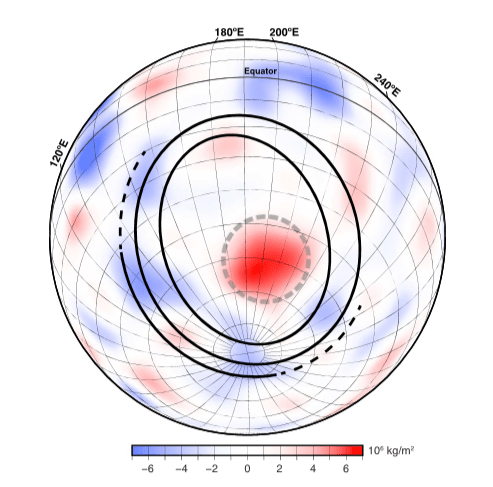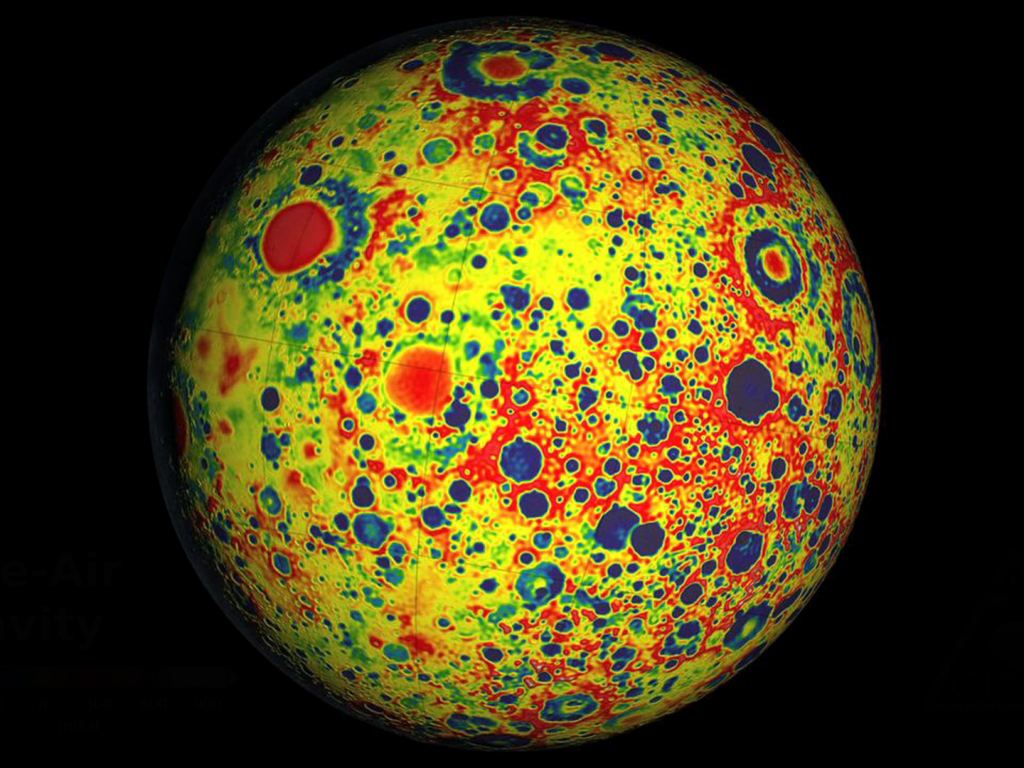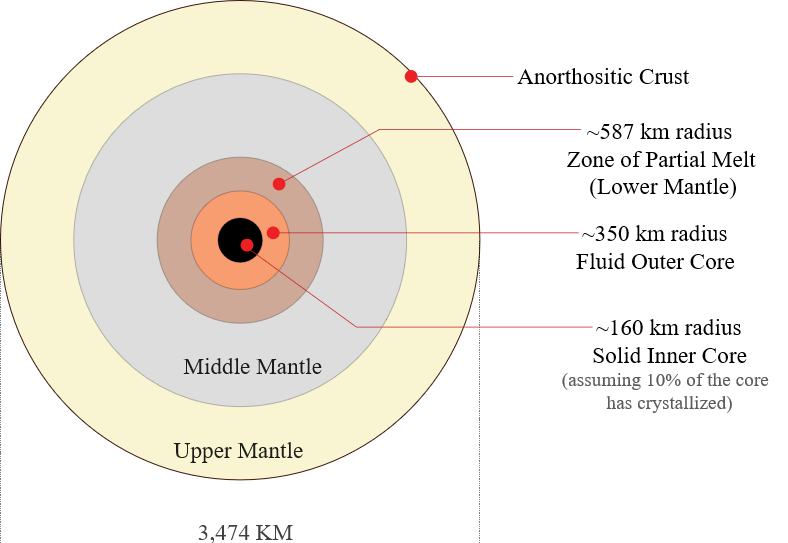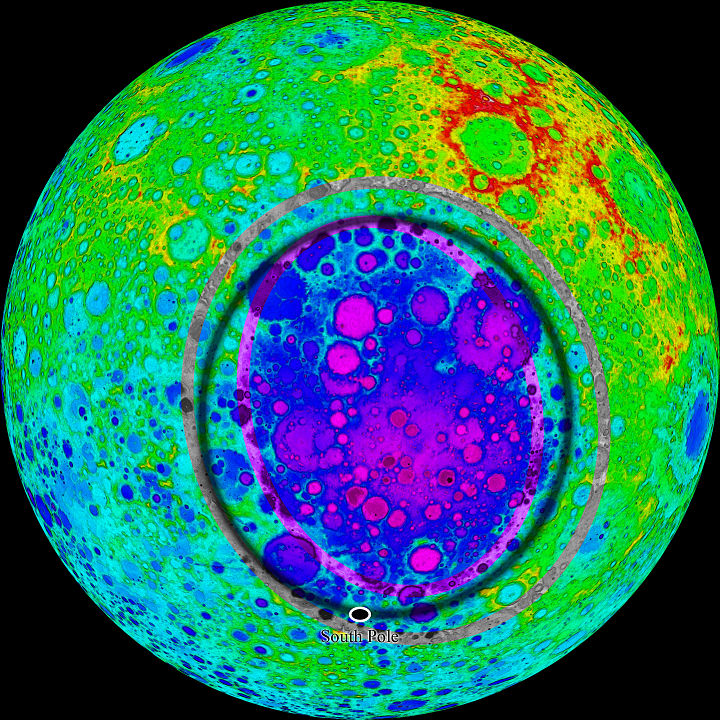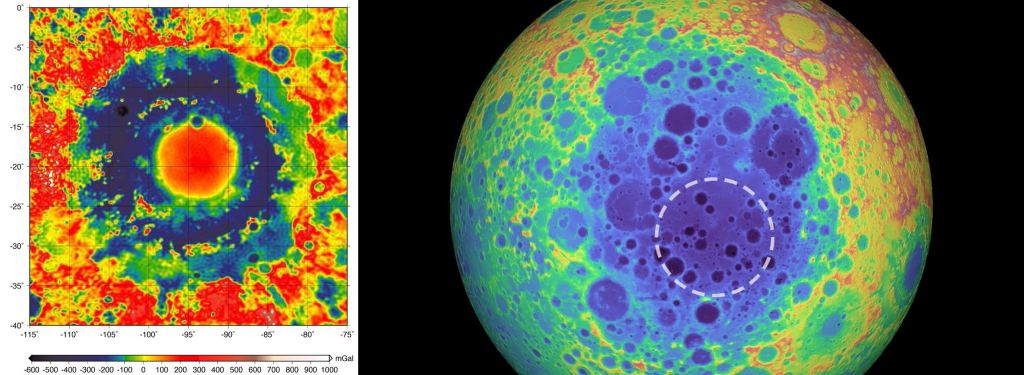One of the largest craters in the Solar System is on our Moon. It's called the South Pole-Aitken (SPA) basin and it's 2,500 km (1,600 mi) in diameter and 13 km (8.1 mi) deep. A new study says that the basin may contain an enormous chunk of metal that's larger than Hawaii's Big Island.
The study, titled " Deep Structure of the Lunar South Pole-Aitken Basin," is published in the Geophysical Research Letters. It's lead author is Peter B. James, Assistant Professor of Planetary Geophysics in Baylor's College of Arts & Sciences. It's based on data from NASA's Gravity Recovery and Interior Laboratory (GRAIL) mission.
The SPA basin is the largest universally-recognized impact crater in the Solar System. It can't be seen from Earth because it's on the far side of the Moon. It's oval shaped, and if it were on Earth it would stretch from Waco, Texas to Washington, DC. With a depth of 13 km (8.1 mi), the crater is about six times deeper than it is wide. Its status as one of the oldest, well-preserved structures on the Moon make the SPA basin a subject of much scientific interest.
Buried under this gargantuan crater is an enormous chunk of metal.
"Imagine taking a pile of metal five times larger than the Big Island of Hawaii and burying it underground. That's roughly how much unexpected mass we detected," said lead author Peter B. James.
The mass is likely hundreds of miles under the lunar surface, but as the paper says, "It could be a large density anomaly distributed across a modest range of depths, or it could be a subtle density anomaly distributed throughout the depth of the mantle."
NASA's GRAIL mission was launched in launched in 2011 and spent about a year mapping the Moon's gravity before being crashed into the Moon in one final maneuver. GRAIL used two spacecraft in the same lunar orbit. They were called GRAIL-A and GRAIL-B, or Ebb and Flow.
As EBB and FLOW flew over areas with differing masses, they moved a little bit toward or away from each other. Precision instruments on the GRAIL spacecraft measure these changes and the data was used to generate a high-resolution image of the Moon's gravitational field.
One of GRAIL's science objectives was to determine the subsurface structure of impact basins and the origin of lunar mascons (mass concentrations.) This study stems from that effort, and combines GRAIL data with data from the Lunar Reconnaissance Orbiter (LRO.)
"When we combined that GRAIL data with lunar topography data from the Lunar Reconnaissance Orbiter, we discovered the unexpectedly large amount of mass hundreds of miles underneath the South Pole-Aitken basin," James said.
Whatever that dense matter is, it's pulling the floor of the crater down by more than a half mile, according to James. Computer simulations suggest that the mass could be an enormous chunk of nickel and iron, and that it was the core of an asteroid that struck the Moon and lodged in the upper mantle.
"One of the explanations of this extra mass is that the metal from the asteroid that formed this crater is still embedded in the Moon's mantle," James said in a press release. According to the new paper, "the excess mass observed in the mantle is approximately equivalent to … a 95-km-diameter iron-nickel core in the Moon's mantle."
They Did the Math and the Math Said...
"We did the math and showed that a sufficiently dispersed core of the asteroid that made the impact could remain suspended in the Moon's mantle until the present day, rather than sinking to the Moon's core," James said.
But that's not the only possibility. Just the obvious one.
The mass of material could be a relic of the Moon's formation. It's possible that it's a concentration of dense oxides from the last stage of lunar magma ocean solidification. The Moon was formed about 4.51 billion years ago, probably as a result of Earth colliding with an ancient protoplanet called Theia. Shortly after it formed, 4.5 billion years ago, its magma oceans cooled and solidified. As they cooled and solidified, one of the last oxides to form would've been FeTiO3, also known as ilmenite. It's very dense and could explain the anomaly.
It's difficult to determine the exact nature of the material beneath the SPA basin. It does seem extremely unlikely that a huge concentration of iron and nickel, if that's what it is, is right underneath one of the Solar System's largest impact craters, without the two being connected.
If it was the result of an asteroid impact, when did it happen? As James told Universe Today, "We don't know, but if the Moon was too hot at the time of the impact, the dense metal from the impactor core probably should have sunk all the way down to the Moon's core, in which case we wouldn't see it."
The preserved crater rim around SPA provides important evidence for establishing the time of impact. As James told Universe Today, "We also wouldn't see a preserved rim if SPA formed in a magma ocean. Therefore, the Moon likely had a chance to cool somewhat before this impact happened."
It's Different Than Other Craters
The SPA basin is different from other impact craters on the Moon. Other craters have a bulls-eye pattern of gravity anomalies, but SPA doesn't. James told Universe today that SPA "has a broad region of weak gravity correlated with a topographic depression that is created by the dense mantle anomaly weighing down the surface of the Moon."
According to James, the basin is "one of the best natural laboratories for studying catastrophic impact events, an ancient process that shaped all of the rocky planets and moons we see today."
Unlocking the secrets of the SPA basin will require more work. Ruling out either an asteroid impact or oxides from magma solidification as the cause of the anomaly will require improved simulations. As James told Universe Today, "The best way to rule out one scenario or the other would be to perform newer and better simulations."
Sources:
- Press Release: Mass Anomaly Detected Under the Moon’s Largest Crater
- Research Paper: Deep Structure of the Lunar South Pole?Aitken Basin
- Wikipedia Entry: South Pole–Aitken basin
- NASA: GRAIL Mission
 Universe Today
Universe Today

